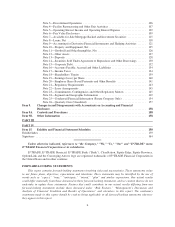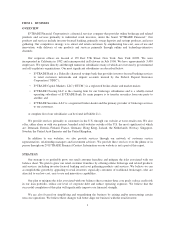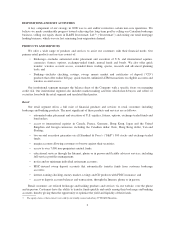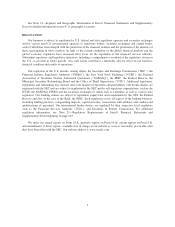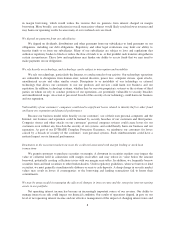eTrade 2008 Annual Report Download - page 12
Download and view the complete annual report
Please find page 12 of the 2008 eTrade annual report below. You can navigate through the pages in the report by either clicking on the pages listed below, or by using the keyword search tool below to find specific information within the annual report.varying asset and liability maturities. We use derivatives to help manage interest rate risk. However, the
derivatives we utilize may not be completely effective at managing this risk and changes in market interest rates
and the yield curve could reduce the value of our financial assets and reduce net operating interest income.
Among other items, we periodically enter into repurchase agreements to support the funding and liquidity
requirements of our Bank. Several market participants have reduced or terminated their participation in the
repurchase agreement market. If we are unsuccessful in maintaining our relationships with counterparties, we
could recognize substantial losses on the derivatives we utilized to hedge repurchase agreements.
If we do not successfully manage consolidation opportunities, we could be at a competitive disadvantage
There has recently been significant consolidation in the financial services industry and this consolidation is
likely to continue in the future. Should we be excluded from or fail to take advantage of viable consolidation
opportunities, our competitors may be able to capitalize on those opportunities and create greater scale and cost
efficiencies to our detriment.
We have acquired a number of businesses and, although currently constrained by the terms of our corporate
debt, may continue to acquire businesses in the future. The primary assets of these businesses are their customer
accounts. Our retention of these assets and the customers of businesses we acquire may be impacted by our
ability to successfully continue to integrate the acquired operations, products (including pricing) and personnel.
Diversion of management attention from other business concerns could have a negative impact. In the event that
we are not successful in our continued integration efforts, we may experience significant attrition in the acquired
accounts or experience other issues that would prevent us from achieving the level of revenue enhancements and
cost savings that we expect with respect to an acquisition.
Risks associated with principal trading transactions could result in trading losses
A majority of our market-making revenues are derived from trading as a principal. We may incur trading
losses relating to the purchase, sale or short sale of securities for our own account, as well as trading losses in our
market maker stocks. From time to time, we may have large positions in securities of a single issuer or issuers
engaged in a specific industry. Sudden changes in the value of these positions could impact our financial results.
Reduced spreads in securities pricing, levels of trading activity and trading through market makers could harm
our market maker business
Computer-generated buy/sell programs and other technological advances and regulatory changes in the
marketplace may continue to tighten securities spreads. Tighter spreads could reduce revenue capture per share
by our market maker, thus reducing revenues for this line of business.
Advisory services subject us to additional risks
We provide advisory services to investors to aid them in their decision making and also provide full service
portfolio management. Investment decisions and suggestions are based on publicly available documents and
communications with investors regarding investment preferences and risk tolerances. Publicly available
documents may be inaccurate and misleading, resulting in recommendations or transactions that are inconsistent
with the investors’ intended results. In addition, advisors may not understand investor needs or risk tolerances,
failures that may result in the recommendation or purchase of a portfolio of assets that may not be suitable for the
investor. To the extent that we fail to know our customers or improperly advise them, we could be found liable
for losses suffered by such customers, which could harm our reputation and business.
Our international operations subject us to additional risks and regulation, which could impair our business
growth
We conduct business in a number of international locations, sometimes through joint venture and/or licensee
relationships. Action or inaction in any of these operations, including the failure to follow proper practices with
respect to regulatory compliance and/or corporate governance, could harm our operations and/or our reputation.
9



